Diffusion of a soluble protein, photoactivatable GFP, through a sensory cilium
- PMID: 20176852
- PMCID: PMC2828910
- DOI: 10.1085/jgp.200910322
Diffusion of a soluble protein, photoactivatable GFP, through a sensory cilium
Abstract
Transport of proteins to and from cilia is crucial for normal cell function and survival, and interruption of transport has been implicated in degenerative and neoplastic diseases. It has been hypothesized that the ciliary axoneme and structures adjacent to and including the basal bodies of cilia impose selective barriers to the movement of proteins into and out of the cilium. To examine this hypothesis, using confocal and multiphoton microscopy we determined the mobility of the highly soluble photoactivatable green fluorescent protein (PAGFP) in the connecting cilium (CC) of live Xenopus retinal rod photoreceptors, and in the contiguous subcellular compartments bridged by the CC, the inner segment (IS) and the outer segment (OS). The estimated axial diffusion coefficients are D(CC) = 2.8 +/- 0.3, D(IS) = 5.2 +/- 0.6, and D(OS) = 0.079 +/- 0.009 microm(2) s(-1). The results establish that the CC does not pose a major barrier to protein diffusion within the rod cell. However, the results also reveal that axial diffusion in each of the rod's compartments is substantially retarded relative to aqueous solution: the axial diffusion of PAGFP was retarded approximately 18-, 32- and 1,000-fold in the IS, CC, and OS, respectively, with approximately 20-fold of the reduction in the OS attributable to tortuosity imposed by the lamellar disc membranes. Previous investigation of PAGFP diffusion in passed, spherical Chinese hamster ovary cells yielded D(CHO) = 20 microm(2) s(-1), and estimating cytoplasmic viscosity as D(aq)/D(CHO) = 4.5, the residual 3- to 10-fold reduction in PAGFP diffusion is ascribed to sub-optical resolution structures in the IS, CC, and OS compartments.
Figures
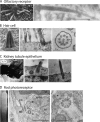
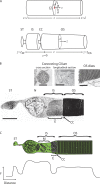
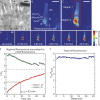

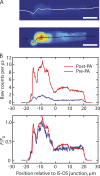



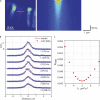
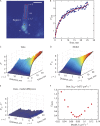
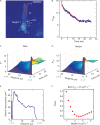
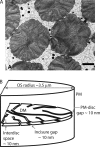

Similar articles
-
Impact of signaling microcompartment geometry on GPCR dynamics in live retinal photoreceptors.J Gen Physiol. 2012 Sep;140(3):249-66. doi: 10.1085/jgp.201210818. Epub 2012 Aug 13. J Gen Physiol. 2012. PMID: 22891277 Free PMC article.
-
Biochemical analysis of a rhodopsin photoactivatable GFP fusion as a model of G-protein coupled receptor transport.Vision Res. 2013 Dec 18;93:43-8. doi: 10.1016/j.visres.2013.10.008. Epub 2013 Oct 16. Vision Res. 2013. PMID: 24140958 Free PMC article.
-
Fluorescence relaxation in 3D from diffraction-limited sources of PAGFP or sinks of EGFP created by multiphoton photoconversion.J Microsc. 2007 Jan;225(Pt 1):49-71. doi: 10.1111/j.1365-2818.2007.01715.x. J Microsc. 2007. PMID: 17286695
-
Protein networks and complexes in photoreceptor cilia.Subcell Biochem. 2007;43:209-35. doi: 10.1007/978-1-4020-5943-8_10. Subcell Biochem. 2007. PMID: 17953396 Review.
-
RPGR: role in the photoreceptor cilium, human retinal disease, and gene therapy.Ophthalmic Genet. 2011 Mar;32(1):1-11. doi: 10.3109/13816810.2010.535889. Epub 2010 Dec 21. Ophthalmic Genet. 2011. PMID: 21174525 Review.
Cited by
-
Light-dependent phosphorylation of Bardet-Biedl syndrome 5 in photoreceptor cells modulates its interaction with arrestin1.Cell Mol Life Sci. 2013 Dec;70(23):4603-16. doi: 10.1007/s00018-013-1403-4. Epub 2013 Jul 2. Cell Mol Life Sci. 2013. PMID: 23817741 Free PMC article.
-
Protein sorting, targeting and trafficking in photoreceptor cells.Prog Retin Eye Res. 2013 Sep;36:24-51. doi: 10.1016/j.preteyeres.2013.03.002. Epub 2013 Apr 3. Prog Retin Eye Res. 2013. PMID: 23562855 Free PMC article. Review.
-
Rhodopsin mutant P23H destabilizes rod photoreceptor disk membranes.PLoS One. 2012;7(1):e30101. doi: 10.1371/journal.pone.0030101. Epub 2012 Jan 19. PLoS One. 2012. PMID: 22276148 Free PMC article.
-
On the Wrong Track: Alterations of Ciliary Transport in Inherited Retinal Dystrophies.Front Cell Dev Biol. 2021 Mar 5;9:623734. doi: 10.3389/fcell.2021.623734. eCollection 2021. Front Cell Dev Biol. 2021. PMID: 33748110 Free PMC article. Review.
-
Three-dimensional architecture of the rod sensory cilium and its disruption in retinal neurodegeneration.Cell. 2012 Nov 21;151(5):1029-41. doi: 10.1016/j.cell.2012.10.038. Cell. 2012. PMID: 23178122 Free PMC article.
References
Publication types
MeSH terms
Substances
Grants and funding
LinkOut - more resources
Full Text Sources

